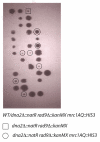Inviability of a DNA2 deletion mutant is due to the DNA damage checkpoint
- PMID: 21508669
- PMCID: PMC3127164
- DOI: 10.4161/cc.10.10.15643
Inviability of a DNA2 deletion mutant is due to the DNA damage checkpoint
Abstract
Dna2 is a dual polarity exo/endonuclease, and 5' to 3' DNA helicase involved in Okazaki Fragment Processing (OFP) and Double-Strand Break (DSB) Repair. In yeast, DNA2 is an essential gene, as expected for a DNA replication protein. Suppression of the lethality of dna2Δ mutants has been found to occur by two mechanisms: overexpression of RAD27 (scFEN1) , encoding a 5' to 3' exo/endo nuclease that processes Okazaki fragments (OFs) for ligation, or deletion of PIF1, a 5' to 3' helicase involved in mitochondrial recombination, telomerase inhibition and OFP. Mapping of a novel, spontaneously arising suppressor of dna2Δ now reveals that mutation of rad9 and double mutation of rad9 mrc1 can also suppress the lethality of dna2Δ mutants. Interaction of dna2Δ and DNA damage checkpoint mutations provides insight as to why dna2Δ is lethal but rad27Δ is not, even though evidence shows that Rad27 (ScFEN1) processes most of the Okazaki fragments, while Dna2 processes only a subset.
Figures





Comment in
-
It's all about flaps: Dna2 and checkpoint activation.Cell Cycle. 2011 Aug 1;10(15):2417-8. doi: 10.4161/cc.10.15.16201. Epub 2011 Aug 1. Cell Cycle. 2011. PMID: 21734450 Free PMC article. No abstract available.
-
The changing view of Dna2.Cell Cycle. 2011 Aug 15;10(16):2620-1. doi: 10.4161/cc.10.16.16545. Epub 2011 Aug 15. Cell Cycle. 2011. PMID: 21829100 No abstract available.
References
-
- Sanchez Y, Desany BA, Jones WJ, Liu Q, Wang B, Elledge SJ. Regulation of RAD53 by the ATM-like kinases MEC1 and TEL1 in yeast cell cycle checkpoint pathways. Science. 1996;271:314–315. - PubMed
-
- Sanchez Y, Bachant J, Wang H, Hu F, Liu D, Tetzlaff M, et al. Control of the DNA damage checkpoint by chk1 and rad53 protein kinases through distinct mechanisms. Science. 1999;286:1166–1171. - PubMed
-
- Zhou Z, Elledge SJ. DUNI encodes a protein kinase that controls the DNA damage response in yeast. Cell. 1993;75:1119–1127. - PubMed
Publication types
MeSH terms
Substances
LinkOut - more resources
Full Text Sources
Molecular Biology Databases
Research Materials
Miscellaneous
